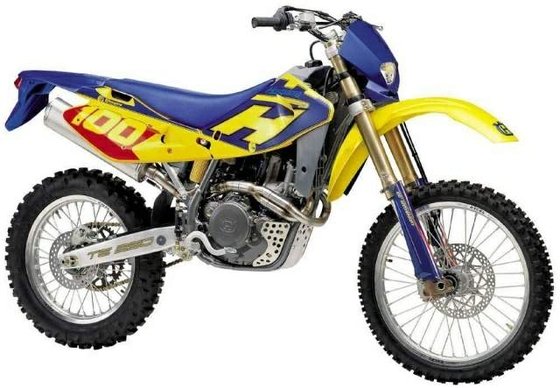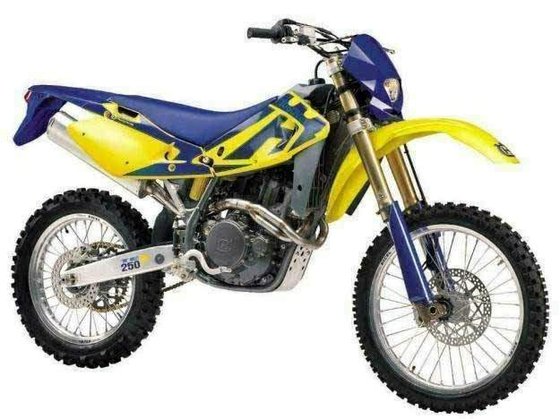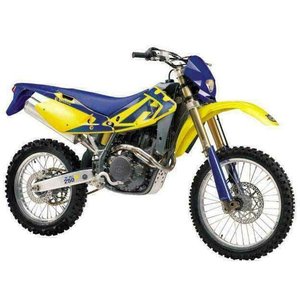Husqvarna TE 250 (2002–2004): A Legacy of Enduro Excellence Revisited

Introduction
The early 2000s marked a pivotal era for Husqvarna. Fresh off World Enduro Championship victories and navigating corporate upheavals, the Swedish-turned-Italian marque solidified its reputation with bikes like the TE 250. Designed as a lightweight, agile enduro machine, the TE 250 (2002–2004) blended race-bred engineering with trail-friendly versatility. As a modern-day rider swinging a leg over this early-2000s icon, it’s clear why this generation remains a cult favorite among off-road enthusiasts. Let’s dive into what makes this bike tick—and why it still resonates today.
Design & Build: Where Heritage Meets Innovation

The TE 250’s design screams purpose. Its steel single-tube cradle frame, paired with a lightweight aluminum rear subframe, strikes a balance between durability and agility. At 108 kg (238 lbs), it’s remarkably svelte for a four-stroke, especially when compared to modern counterparts. The bike’s silhouette is unmistakably Husqvarna: minimalist, aggressive, and adorned with the brand’s 100th-anniversary graphics (a nod to its 1903 origins, albeit a year late).
Standout Features:
- Electric Starter: A game-changer in 2002. The inclusion of a “red button” eliminated the dread of stalling in technical terrain. Paired with a kickstarter, it offered peace of mind for remote adventures.
- Premium Components: A titanium exhaust, hydraulic clutch, and Marzocchi USD forks hinted at Husqvarna’s racing pedigree. Wide footpegs and adjustable Renthal-style bars (aftermarket options were common) catered to customization.
- Liquid Cooling: Rare for small-displacement thumpers of the era, this ensured consistent performance during grueling climbs or slow-speed trail work.
Engine Performance: The Sweet Spot of Versatility
At the heart of the TE 250 lies a 249 cc liquid-cooled DOHC four-stroke. With a 76 x 55 mm bore/stroke and a 12:1 compression ratio, this engine prioritizes tractable torque over outright aggression. The 38mm Keihin carburetor (a relic in today’s fuel-injected world) delivers crisp throttle response once dialed in.
On the Trail:
- Low-End Grunt: The engine pulls cleanly from idle, making it a hero in muddy ruts or rocky ascents. You’ll rarely need to clutch-abuse to keep momentum.
- Midrange Surge: Between 5,000–8,000 RPM, the TE 250 comes alive. It’s no fire-breathing MX bike, but the linear powerband encourages confident throttle chops through flowing singletrack.
- Six-Speed Gearbox: The wide-ratio transmission lets you crawl at 15 km/h (9 mph) in sixth gear or scream to 110 km/h (68 mph) on fire roads. Shifts are buttery, though the clutch demands occasional adjustment to prevent drag.
Handling & Suspension: Conquering Chaos with Poise
Husqvarna’s chassis geometry—1,485 mm (58.5") wheelbase and 365 mm (14.4") ground clearance—nails the sweet spot between stability and flickability. The Marzocchi 45mm USD forks and Sachs rear shock (both fully adjustable) handle everything from MX track whoops to root-infested trails.
Test Ride Impressions:
- Motocross Track: Landing tabletops? The TE 250 feels planted mid-air but will bottom harshly on big hits—stiffening compression damping is a must.
- Technical Woods: Here’s where it shines. The bike darts between trees with the urgency of a 125cc two-stroke, yet the 21"/18" wheel combo (90/90-21 front, 120/80-18 rear) floats over babyheads.
- Ergonomics: The 890 mm (35") seat height suits taller riders, but the plank-like seat foam had me standing through every straightaway. Aftermarket solutions (hint: MOTOPARTS.store’s gel seats) are a godsend.
Competition: How the TE 250 Stacks Up
In the early 2000s, the TE 250 faced fierce rivals. Here’s how it measured up:
Yamaha WR250F (2002–2004):
- Engine: Yamaha’s 250cc DOHC four-stroke felt peppier up top but required more clutch work in technical sections.
- Weight: At 112 kg (247 lbs), the WR was slightly heavier, noticeable in tight switchbacks.
- Suspension: KYB components were plush but less adjustable than Husky’s Marzocchi/Sachs setup.
- Electric Start: Absent on the WR until 2003, a critical disadvantage for enduro riders.
KTM 250 EXC (2002–2004):
- Engine: KTM’s carbureted 250cc mill rivaled the TE’s low-end but vibed more at high RPM.
- Components: WP suspension was plusher out of the box, but the Husky’s hydraulic clutch offered smoother modulation.
- Price: KTM commanded a premium, making the TE 250 a value play for budget-conscious racers.
Verdict: The TE 250 split the difference between Yamaha’s reliability and KTM’s race-ready edge. Its electric start and six-speed gearbox gave it an edge for all-day endurance events.
Maintenance: Keeping the Legend Alive
The TE 250’s simplicity is a mechanic’s dream. Here’s what to watch—and how MOTOPARTS.store can help:
Key Considerations:
- Air Filter Maintenance: The foam filter demands frequent cleaning (every 10–15 hours). Upgrade to a Twin Air kit for better airflow and durability.
- Valve Adjustments: Check every 30 hours. Shims are readily available, and the DOHC design simplifies access.
- Carb Tuning: The Keihin MX carb can be finicky in altitude changes. A JD Jet Kit smooths out hiccups.
- Suspension Refresh: Sachs shock seals wear after 100 hours. Rebuild kits restore that buttery feel.
Recommended Upgrades:
- Skid Plate: The magnesium engine casing is vulnerable. A Moose Racing aluminum guard adds protection.
- Sprockets/Chain: Swap to a DID 520ERT chain and steel sprockets for longevity.
- Brake Pads: EBC sintered pads improve bite on the 260mm front disc.
Conclusion: A Timeless Trail Partner
The Husqvarna TE 250 (2002–2004) remains a benchmark for accessible enduro performance. Its blend of lightweight agility, bulletproof engineering, and race-ready components makes it a joy to ride—even two decades later. While modern bikes boast fuel injection and traction control, the TE 250 reminds us that sometimes, simplicity is the ultimate sophistication.
Whether you’re resurrecting a barn find or optimizing a well-loved example, MOTOPARTS.store has the gear to keep your Husky charging harder, longer, and smarter. Now, go get dirty.
Specifications sheet
| Engine | |
|---|---|
| Stroke: | Four-stroke |
| Ignition: | Electronic |
| Fuel system: | 38mm Keihin MX carburetor |
| Displacement: | 249 ccm |
| Configuration: | Single |
| Cooling System: | Liquid cooled |
| Starting system: | Electric & kick |
| Compression ratio: | 12.0:1 |
| Number of cylinders: | 1 |
| Dimensions | |
|---|---|
| Wheelbase: | 1485 mm (58.5 in) |
| Dry weight: | 108 |
| Seat height: | 890 mm (35.0 in) |
| Ground clearance: | 365 mm (14.4 in) |
| Fuel tank capacity: | 8 L (2.1 US gal) |
| Drivetrain | |
|---|---|
| Clutch: | Wet multiplate |
| Final drive: | chain |
| Transmission: | 6-speed |
| Maintenance | |
|---|---|
| Engine oil: | 10W-40 (recommended) |
| Brake fluid: | DOT 4 |
| Spark plugs: | NGK CR8E or NGK CR8EIX |
| Rear tire pressure: | Not specified (check manual) |
| Front tire pressure: | Not specified (check manual) |
| Chassis and Suspension | |
|---|---|
| Frame: | Steel single tube cradle with light alloy rear frame |
| Rear tire: | 120/80-18 |
| Front tire: | 90/90-21 |
| Rear brakes: | Single 220 mm disc |
| Front brakes: | Single 260 mm disc |
| Rear suspension: | Sachs Soft Damp monoshock, spring preload, compression, and rebound adjustment |
| Front suspension: | Marzocchi USD telescopic fork, compression and rebound adjustment |



















